Helen Keller: Vaudeville Star
In 1919 Helen Keller was 39 years old and an international celebrity, but she was having trouble paying the bills. So she took her act on the road.
WHO WAS HELEN KELLER?
Born in Alabama in 1880, Helen Keller was a cheerful, bright baby who was just beginning to learn to talk. Then, at 19 months old, she contracted a high fever that left her blind, deaf, and unable to speak. All of a sudden, Helen's normal development stopped and she became a "wild child" -she ate with her hands, threw food, and broke things. The Keller's relatives urged her affluent parents to send the little girl to an asylum, which was a too-common destination for blind-deaf people in those days. But Mrs. Keller knew that inside her angry daughter was an intelligent girl trying desperately to communicate.
So when Helen was six years old, her parents brought her to the famous inventor Alexander Graham Bell, who was trying to find a way to cure deafness. Bell was unable to help Helen but recommended the Perkins School for the Blind in Boston. The school's headmaster decide that Helen needed constant home care and sent a 20-year-old teacher named Annie Sullivan, a recent graduate of the school, who was herself partially blind. Sullivan had no experience with deaf-blind students, but after a rough start, she had a major breakthrough when she got Helen to understand the connection between actual water and the letters "w-a-t-e-r," which Sullivan spelled using sign language in Helen's hand.
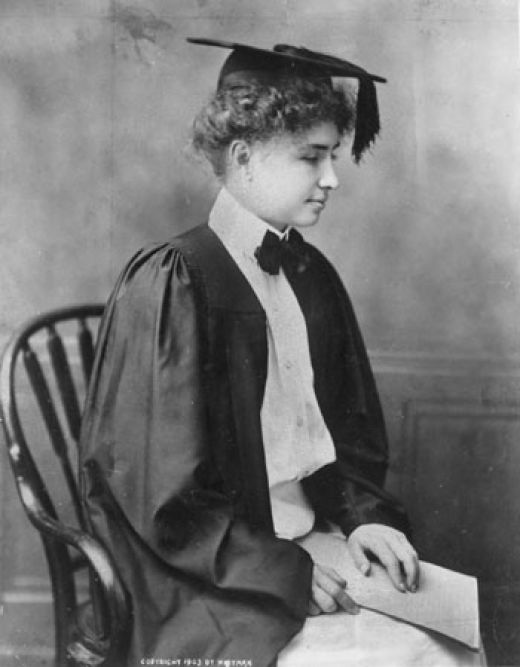 AN UNLIKELY CELEBRITY
AN UNLIKELY CELEBRITYAfter that, a whole new world opened up for Keller. Under Sullivan's tutelage, she excelled at reading and writing, and in 1904 she became the first deaf-blind person in history to graduate from college. Keller had been famous since childhood thanks to a series of article written about her by the headmaster at Perkins, but her celebrity skyrocketed after her first book, The Story of My Life, was published when she was 22 years old. Keller then became an advocate for the deaf-blind, as well as a political activist -touting socialism, worker's rights, and pacifism. But she was most famous for simply being Helen Keller.
OPPORTUNITY KNOCKS
Starting in Keller's teenage years, vaudeville promoters came calling. At Sullivan's urging, Keller always politely declined, explaining that she made her living writing books and giving formal lectures -not by appearing in front of rowdy crowds who paid a nickel each to gawk at (and heckle) jugglers, comedians, and singers, not to mention "freak" acts such as the dog-faced boy or Siamese twins. Even though vaudeville shows were advertised as "family entertainment," audiences could get out of hand.
But in 1919 Keller convinced Sullivan to let her take the job. The pros just outweighed the cons. For one, Keller's two previous books hadn't sold well, and the money she was making on the Chautauqua adult-education lecture circuit wasn't enough to sustain her. And because they had to travel to a new town for each lecture, the daily schedule was becoming too hectic for Sullivan, whose eyesight and health were growing worse. Doing vaudeville shows would allow them to stay in the same town for a week at a time, rather than traveling nearly every day.
Another factor that led Keller to vaudeville: She disapproved of the way Hollywood had told her story in a 1919 silent movie based on her life called Deliverance, in which she and Sullivan appeared as themselves at the end. The film glossed over a lot of details about her life, and completely avoided her political views. Vaudeville would give Keller a chance to set the record straight.
And finally, Keller was a people person, and she knew that vaudeville would be a great way to educate the masses about the struggles of the disabled. So against her family's wishes, she signed on to the Orpheum vaudeville circuit.
NATURAL-BORN KELLERS
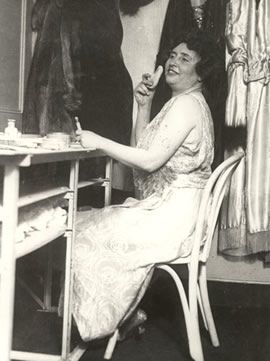 Keller
knew that her decision to become a vaudeville performer was risky. How
would the crowds treat her -like a freak, or as a respected speaker?
There were, in essence, two Helen Kellers. "The sweet myth, the
canonical one, portrays her as an angel upon earth, saved from the
savagery of darkness and silence," wrote Keller biographer Walter
Kendrick. But the real Keller was not so angelic -she was a fiery,
middle-aged woman who espoused radical left-wing ideals and spoke out
against the United States' involvement in World War I, which most
Americans supported. With vaudeville, Keller's ambitious goal was to put
on an entertaining, educational act without compromising her ideals.
Keller
knew that her decision to become a vaudeville performer was risky. How
would the crowds treat her -like a freak, or as a respected speaker?
There were, in essence, two Helen Kellers. "The sweet myth, the
canonical one, portrays her as an angel upon earth, saved from the
savagery of darkness and silence," wrote Keller biographer Walter
Kendrick. But the real Keller was not so angelic -she was a fiery,
middle-aged woman who espoused radical left-wing ideals and spoke out
against the United States' involvement in World War I, which most
Americans supported. With vaudeville, Keller's ambitious goal was to put
on an entertaining, educational act without compromising her ideals. The public, in turn, wanted to see for themselves whether Keller could actually do all the things for which she was credited. Because deaf-blind people were often institutionalized, most people assumed they were "retarded." Indeed, rumors had persisted for years that Keller was not the writer she was made out to be, that she really didn't master five languages, and that her books were ghostwritten frauds. Furthermore, her critics charged, Keller was incapable of having sophisticated political opinions -Sullivan and her husband, John Macy, were using Keller to espouse their Marxist views. Keller was ready to prove that she did her own thinking.
The first shows were scheduled for early 1920 at the Palace Theater in New York City, one of vaudeville's premier venues. The playbill advertised:
Blind, deaf, and formerly DUMB, Helen Keller presents a remarkable portrayal of the triumph of her life over the greatest obstacles that ever confronted a human being!HELEN BACK AGAIN
Billed as "The Star of Happiness," the 20-minute act began with the curtain rising to reveal Sullivan sitting in a drawing room. As Mendelssohn's "Spring Song" played, Sullivan spent the first few minutes chronicling Keller's rise from a sightless, soundless childhood to a prosperous adulthood (basically the same story later made famous by William Gibson's 1959 play The Miracle Worker). Then Sullivan led Keller onto the stage. Keller sat at a piano and exclaimed loudly, "It is very beautiful!" For the audience, this was a surprise. Despite what the poster said, Keller was rumored to be mute. But Keller proved that she could indeed talk, albeit very poorly -only her inner circle could understand what she said, so Sullivan was always there to translate. Said one audience member after hearing Keller recite the Lord's Prayer: "Her voice was the loneliest sound in the world."
But the performances were by no means somber affairs. Keller smiled throughout as Sullivan told stories about her, including one about her lifetime friendship with Samuel Clemens, who once said after a meeting with Keller, "Blindness is an exciting business. If you don't believe it, get up some dark night on the wrong side of your bed when the house is on fire and try to find the door." The crowd laughed at the jokes, and watched intently as Keller demonstrated how she could "hear" a human voice: She placed her hand on Sullivan's face -the first finger resting on the mouth, the second finger beside the bridge of the nose, and the thumb resting on the throat. Keller could then feel the vibrations created by the voice and understand Sullivan's words.
Q&A
The most popular part of the act came at the end when Keller took questions from the audience as Sullivan translated. This gave Keller a chance to show off her quick wit …and to push her socialist views (which were actually better received on the vaudeville stage than they were on the conservative Chautauqua circuit). A few recorded exchanges:
Q: How old are you?IT'S A HIT!
A: Between 16 and 60.
Q: What do think is the most important question before the country today?
A: How to get a drink. [Prohibition had recently banned the sale of alcohol.]
Q: Do you believe all political prisoners should be released?
A: Certainly. They opposed the war on the grounds that it was commercial war. Now everyone with a grain of sense says it was. Their crime is, they said it first.
Q: Does talking tire you?
A: Did you ever hear of a woman who tired of talking?
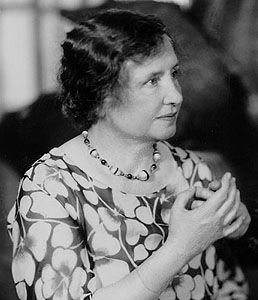 Audiences loved "The Star of Happiness." And so did the critics. The New York Times wrote,
"Keller has conquered again, and the Monday afternoon audience at the
Palace, one of the most critical and cynical in the world, was hers."
Everywhere Keller and Sullivan went throughout the United States and
Canada, crowds greeted them warmly. "At first it seemed strange to find
ourselves on a program with dancers, acrobats, and trained animals,"
Keller later wrote. "But the very difference between ourselves and the
other actors gave novelty and interest to our work." Keller and Sullivan
were paid in the top tier for vaudevillians -$2,000 per week.
Audiences loved "The Star of Happiness." And so did the critics. The New York Times wrote,
"Keller has conquered again, and the Monday afternoon audience at the
Palace, one of the most critical and cynical in the world, was hers."
Everywhere Keller and Sullivan went throughout the United States and
Canada, crowds greeted them warmly. "At first it seemed strange to find
ourselves on a program with dancers, acrobats, and trained animals,"
Keller later wrote. "But the very difference between ourselves and the
other actors gave novelty and interest to our work." Keller and Sullivan
were paid in the top tier for vaudevillians -$2,000 per week. After a show in Syracuse, New York, Keller wrote in a letter to her mother: "The audience was interested in me, they were so silent, paying the closest attention. Indeed, some days there wasn't a clap and yet we knew they were deeply interested. After a while, they found their tongue and asked more questions than we could answer." Other times, Keller wasn't as pleased with the crowds: "Although I love the people, they appear so superficial. They are peculiar in that you must say a good thing in your first sentence, or they won't listen, much less laugh. Still, they have shown us such friendliness. I'm grateful to them."
SIGNING OUT
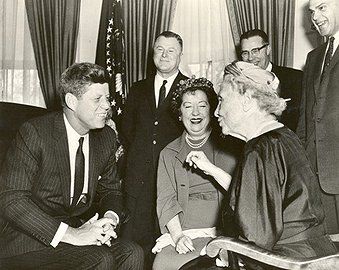 Keller
quite the vaudeville circuit in 1924 when Sullivan's sight and overall
health became too poor for her to continue. Besides, Keller had bigger
plans. Now under the care of Sullivan's secretary, Polly Thompson, she
amped up her advocacy. That same year she became a spokesperson for the
American Foundation for the Blind and was already a founding member of
the American Civil Liberties Union. She then began traveling the world
to advocate for people who faced discrimination or any other blows that
life dealt them. During World War II, she visited disabled veterans to
demonstrate -through her mere presence- that they could still accomplish
great things. In 1948 she toured the Japanese cities of Hiroshima and
Nagasaki just three years after the atomic bombs were dropped. In all,
Keller traveled to 39 countries and met with every president from Grover
Cleveland in 1888 to to Lyndon Johnson, who awarded her the
Presidential Medal of Freedom in 1964.
Keller
quite the vaudeville circuit in 1924 when Sullivan's sight and overall
health became too poor for her to continue. Besides, Keller had bigger
plans. Now under the care of Sullivan's secretary, Polly Thompson, she
amped up her advocacy. That same year she became a spokesperson for the
American Foundation for the Blind and was already a founding member of
the American Civil Liberties Union. She then began traveling the world
to advocate for people who faced discrimination or any other blows that
life dealt them. During World War II, she visited disabled veterans to
demonstrate -through her mere presence- that they could still accomplish
great things. In 1948 she toured the Japanese cities of Hiroshima and
Nagasaki just three years after the atomic bombs were dropped. In all,
Keller traveled to 39 countries and met with every president from Grover
Cleveland in 1888 to to Lyndon Johnson, who awarded her the
Presidential Medal of Freedom in 1964. By the time Keller died peacefully in her sleep in 1968, her stint in vaudeville was a mere blip in her 87 years, but she remembered it with fondness. "I found the world of vaudeville much more amusing than the world I always lived in. I like to feel the warm pulse of human life pulsing round and round me."
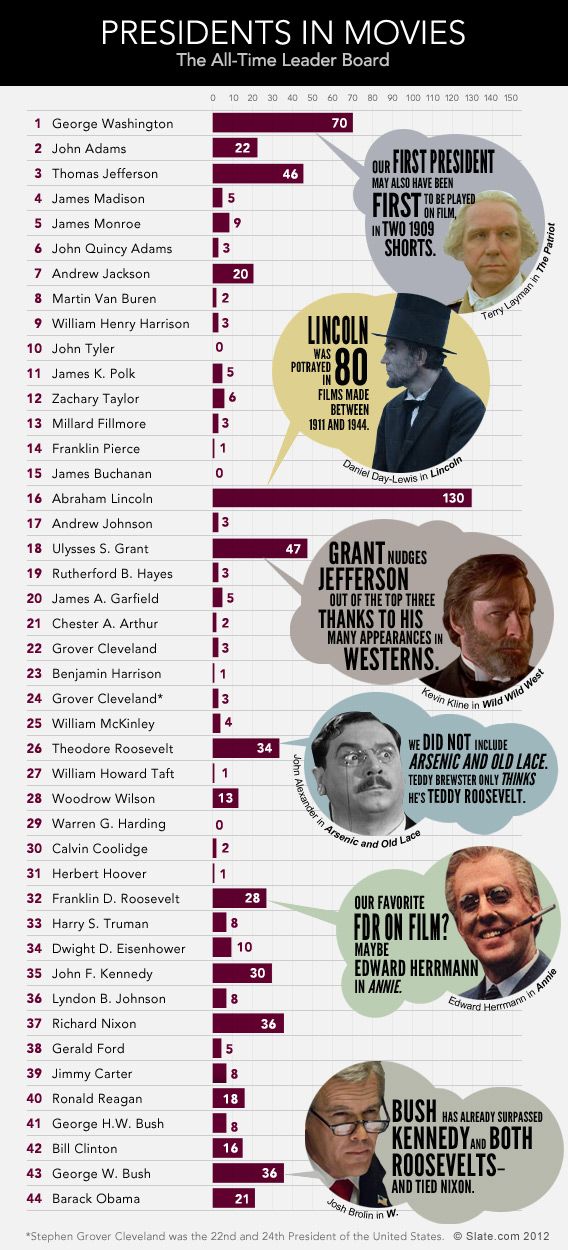
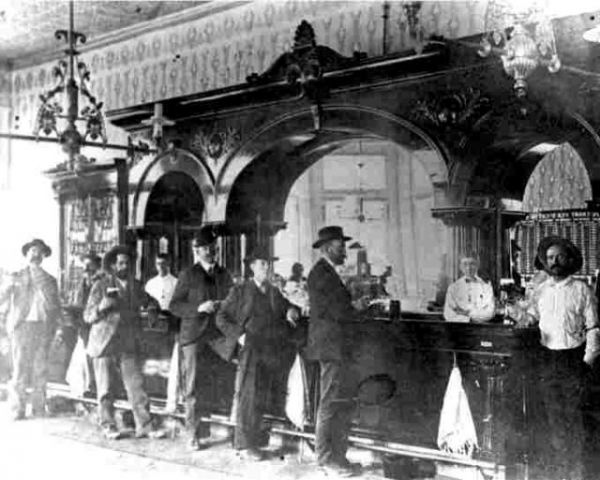
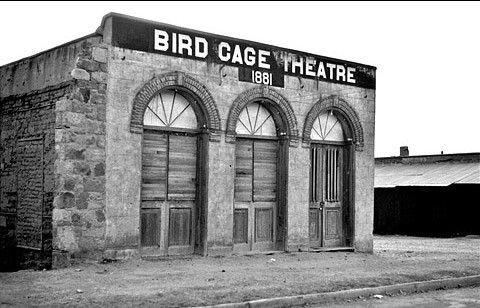 6. He loved hookers and prostitutes.
Wyatt may not have been a drinker, but he loved the ladies (ladies of
the evening, that is). In one year (1872) Wyatt was arrested three times
for "keeping and being found in a house of ill-repute."
6. He loved hookers and prostitutes.
Wyatt may not have been a drinker, but he loved the ladies (ladies of
the evening, that is). In one year (1872) Wyatt was arrested three times
for "keeping and being found in a house of ill-repute."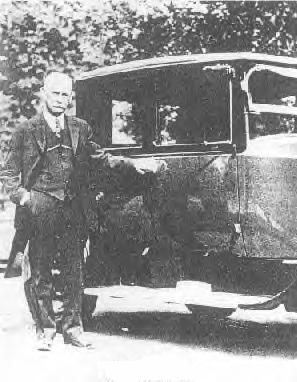 11. He was a pal of John Wayne.
In Wyatt's later years, he lived in Los Angeles and was a technical
advisor on several silent cowboy films. He befriended a young actor
named Marion Morrison (who later changed his name to John Wayne) and
regaled the young thespian with tales of the Old West. Enthralled, the
young Duke used to fetch Wyatt cups of coffee. Wayne later claimed his
portrayals of cowboys and Western lawmen were based on these
conversations with Wyatt Earp.
11. He was a pal of John Wayne.
In Wyatt's later years, he lived in Los Angeles and was a technical
advisor on several silent cowboy films. He befriended a young actor
named Marion Morrison (who later changed his name to John Wayne) and
regaled the young thespian with tales of the Old West. Enthralled, the
young Duke used to fetch Wyatt cups of coffee. Wayne later claimed his
portrayals of cowboys and Western lawmen were based on these
conversations with Wyatt Earp.